This easy homemade sourdough pasta couldn’t be easier. You only need 3 ingredients and can use an active sourdough starter or discard. Whip up a quick version or long ferment for more health benefits and better digestibility.
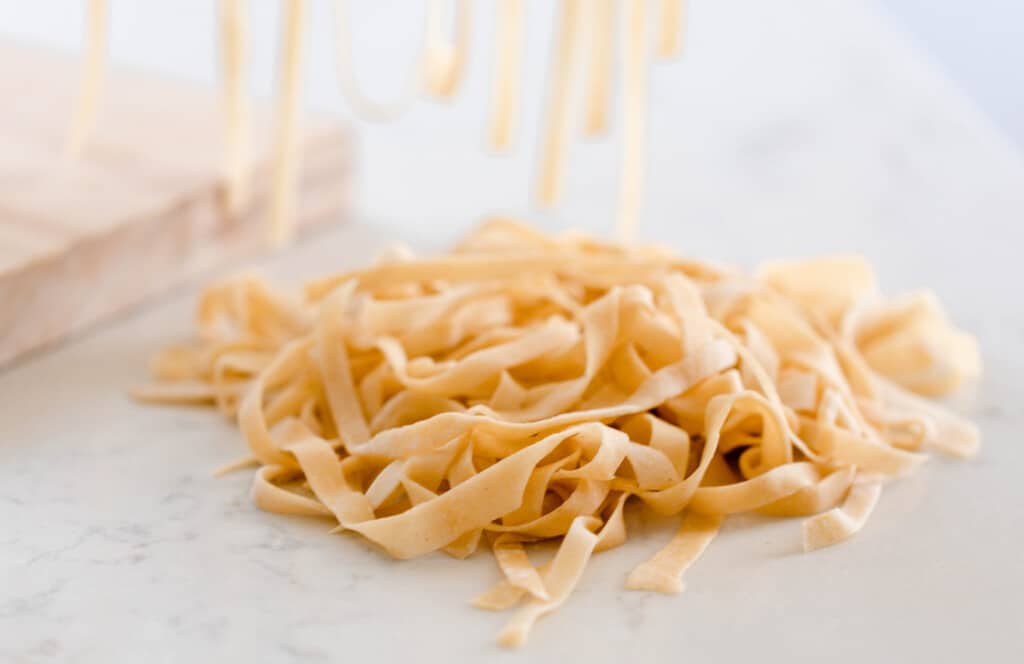
Pasta is one of the easiest recipes to make and takes only 3 ingredients and a little time. Yet, it is something most of us don’t think twice about buying pre made. Why make homemade pasta when you can just pop open a box?
Foremost, there is no comparison in taste and texture between homemade and boxed. Especially when you add the sourdough factor, the taste is more complex and flavorful.
The one problem I have with making it myself…the pasta maker.
I have a pasta roller/cutter attachment for my KitchenAid stand mixer, but I hate getting it out. This is what stops me from making pasta 99% of the time. It’s a small thing, but in the middle of a busy day it’s an impossible task to me.
This sourdough pasta dough is so easy to roll out paper thin by hand, that I find I can skip digging all the clunky implements out of the pantry.
Now, I have zero excuses.
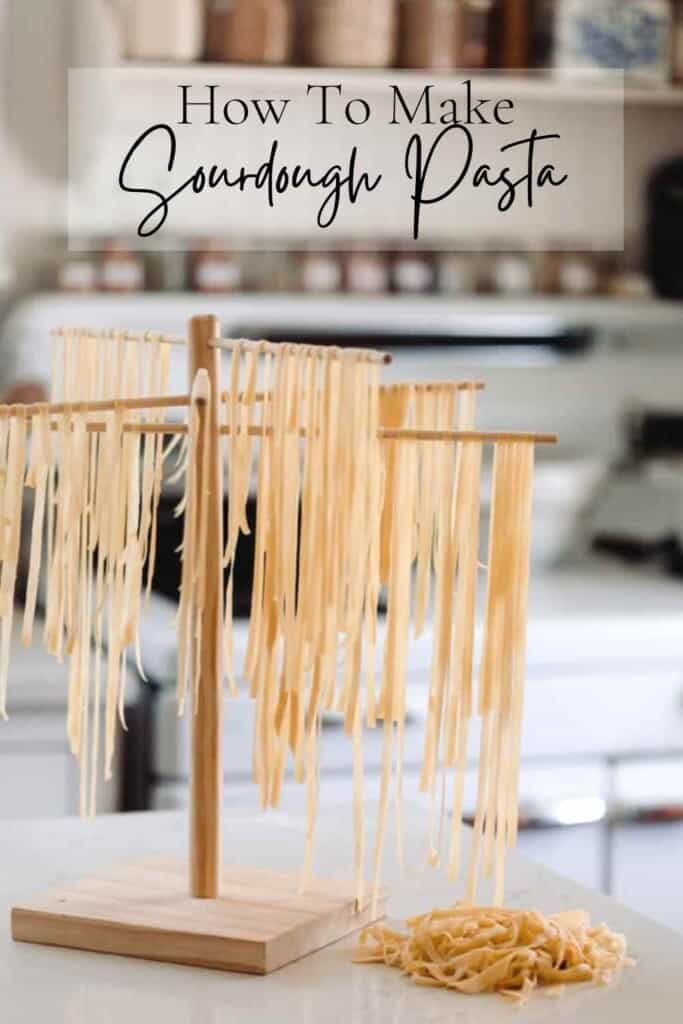
Sourdough Pasta Making Tips:
- You can make this recipe with or without a pasta maker. Use a rolling pin to roll out the dough super thin and slice with a pizza cutter or knife.
- The dough may get quite sticky while you are thinning it out. Just add more flour.
- You can make a quick version of this recipe or long ferment for better digestibility.
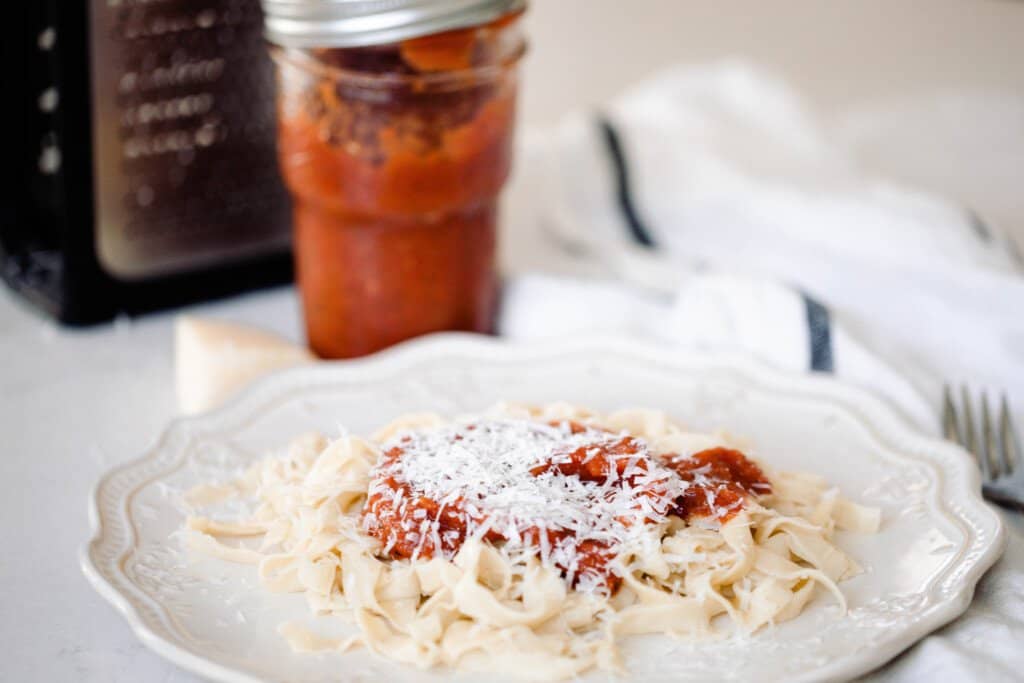
Why you will love this recipe:
Flavor: This sourdough version packs tons of flavor especially compared to regular, store-bought, dried pasta. Want even more flavor? Long ferment the dough to bring out more of that sourdough tang.
Healthy: The best part about making food from scratch is control of the ingredients used. For instance, pasture raised eggs are incredibly nutritious. Also, I love using freshly ground wheat, which contains more nutrients compared to flour that has been sitting on a shelf for months. No time to grind your own? Use unbleached flour without synthetic vitamins added. Lastly, sourdough starter contains fermented grains which are easier to digest.
Easier to digest: One of the main benefits of sourdough, besides more nutrients and better nutrient absorption, is that it is much easier to digest, particularly for those that may be sensitive to gluten. If you are sensitive to gluten, I suggest allowing the dough to ferment for 24 hours. See directions below.
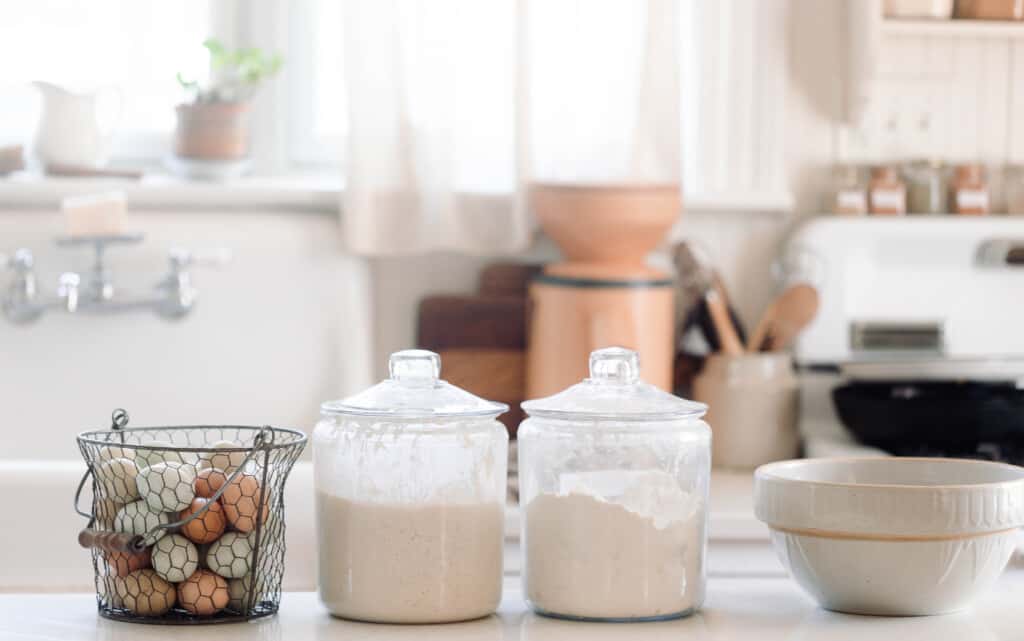
Ingredients:
Sourdough starter – Discard or fed starter will work for this recipe. This is a great way to use up discard that would usually just be tossed out.
Flour – All-purpose flour or freshly ground.
Eggs – Preferably pastured raised, but any egg will do.
This post contains affiliate links, which means I make a small commission at no extra cost to you. See my full disclosure here.
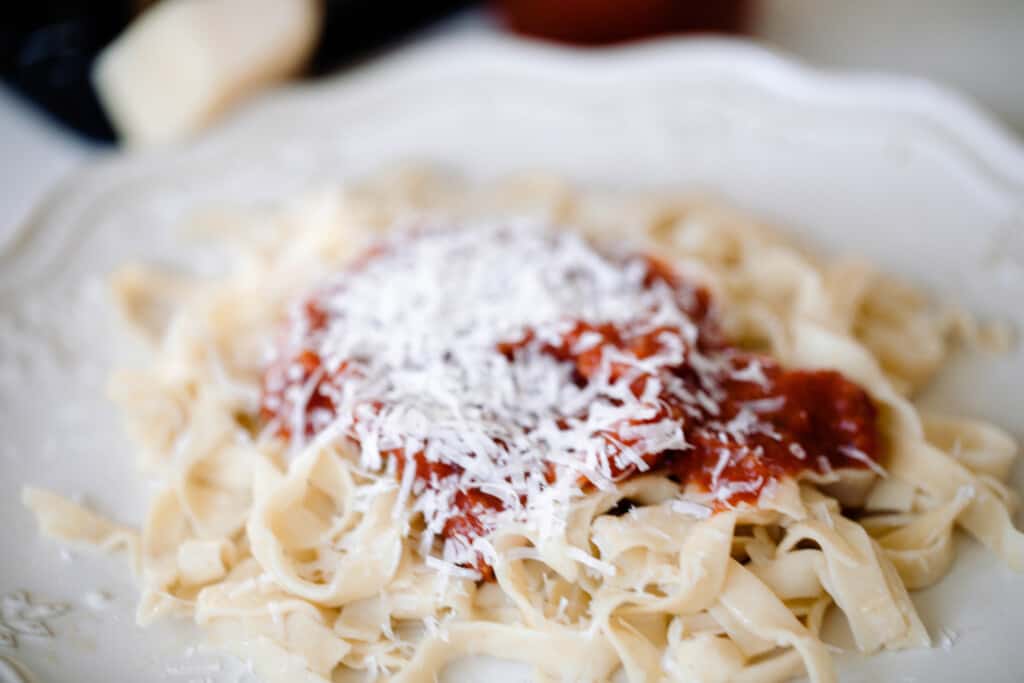
Tools you may need:
Stand mixer (optional)
Pasta maker/cutter – like this one (optional)
Measuring cups
Pasta drying rack (optional)
FAQ:
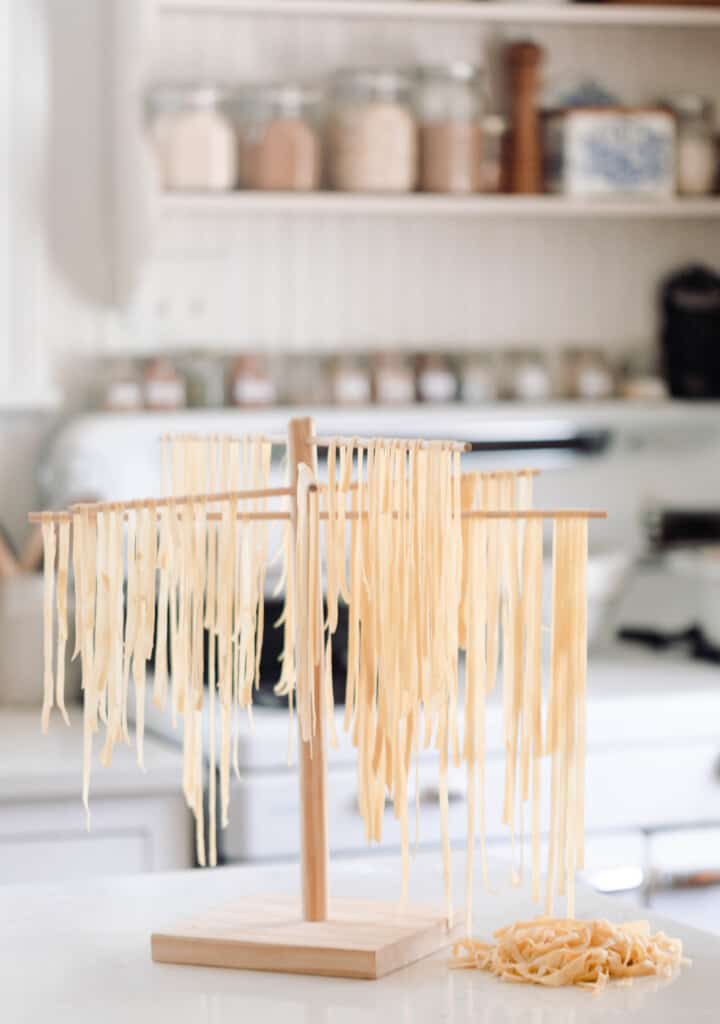
Is sourdough pasta better for you?
Yes! Thanks to the fermentation process of the flour from the sourdough starter, the grains become more digestible and the phytic acid is broken down making the nutrients available in the flour easier for your body to absorb.
Is sourdough pasta easier to digest?
As long as the dough is fermented, it will be easier to digest. This is because the fermentation process helps break down some of the gluten making it more tolerable to those that have gluten sensitivities.
What type of flour should I use?
All-purpose, spelt, or freshly ground wheat will work in this recipe.
What type of sourdough starter can I use?
Discard or active starter can both be used in this recipe.
How long does pasta need to dry?
Fresh homemade pasta needs to dry 12-24 hours or longer before storage. For fresh cooking, allow to dry for at least 30 minutes to 2 hours.
Can I make other shapes of sourdough pasta?
Yes! You are not obligated to just make fettuccine or spaghetti with this recipe. You could also use it to make ravioli, penne, bow tie (farfalle), orecchiette, and more.
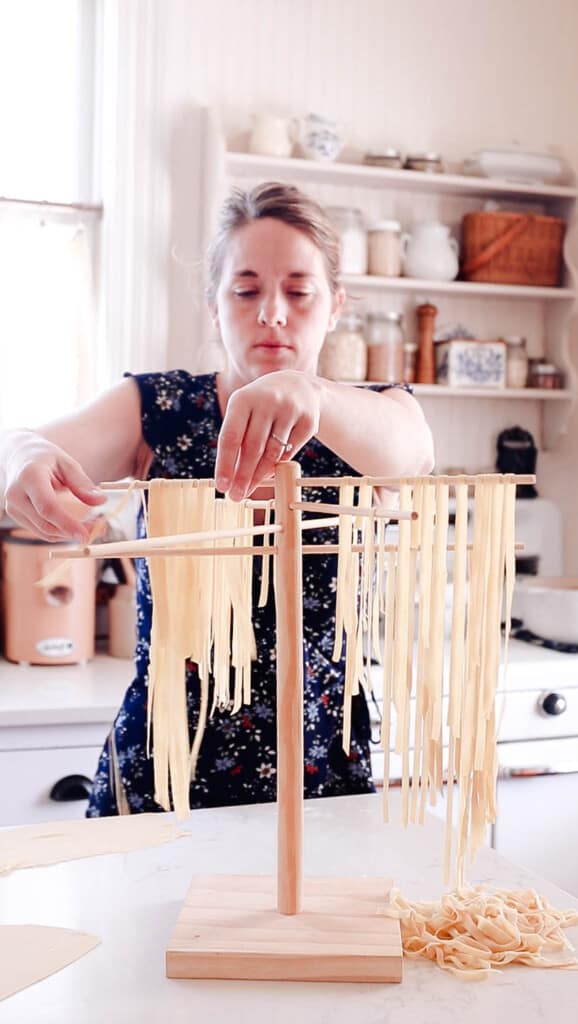
How To Make Sourdough Pasta
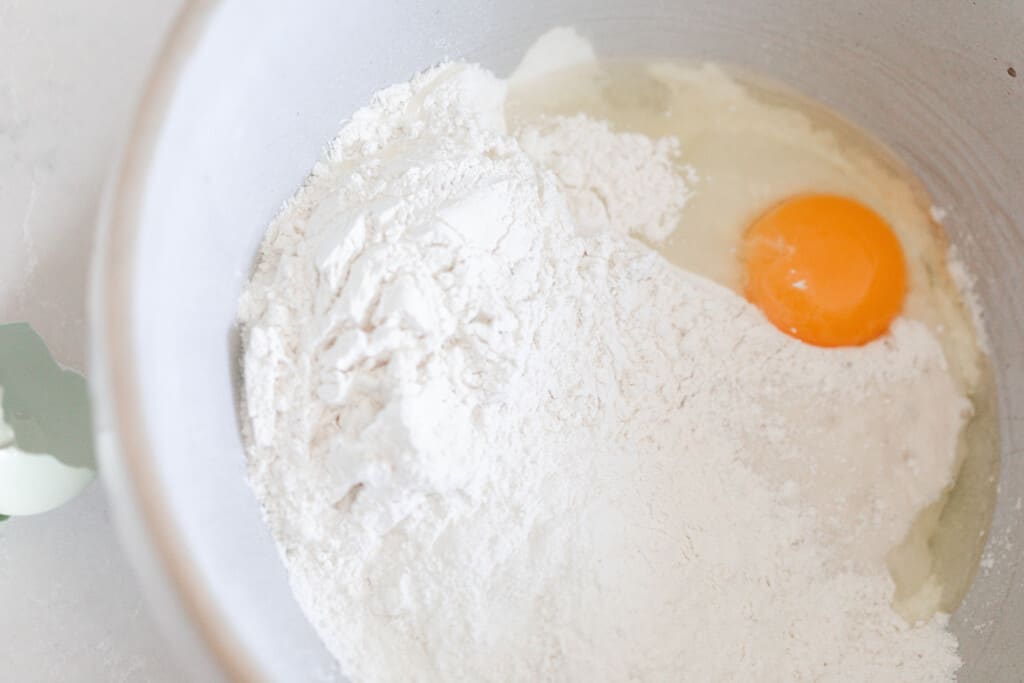
Quick Version
Place the ingredients in a stand mixer with a dough hook.
Mix on low/medium until the dough is smooth and stretchy, about 10 minutes. You can also do this by hand. Add flour to a clean surface, make a well. Add eggs and sourdough starter to the well and whisk together the wet ingredients. Incorporate the rest of the flour and knead by hand for 10 minutes or so.
Allow the dough to rest for 30 minutes.
How To Make Long Fermented Sourdough Pasta
Make the pasta as directed above in the quick version.
Instead of only allowing the dough to rest for 30 minutes, allow it to ferment covered for 2-6 hours and then refrigerate up to 24 hours. You want to cover it so it doesn’t dry out.
Rolling And Shaping
To make pasta without a pasta cutter:
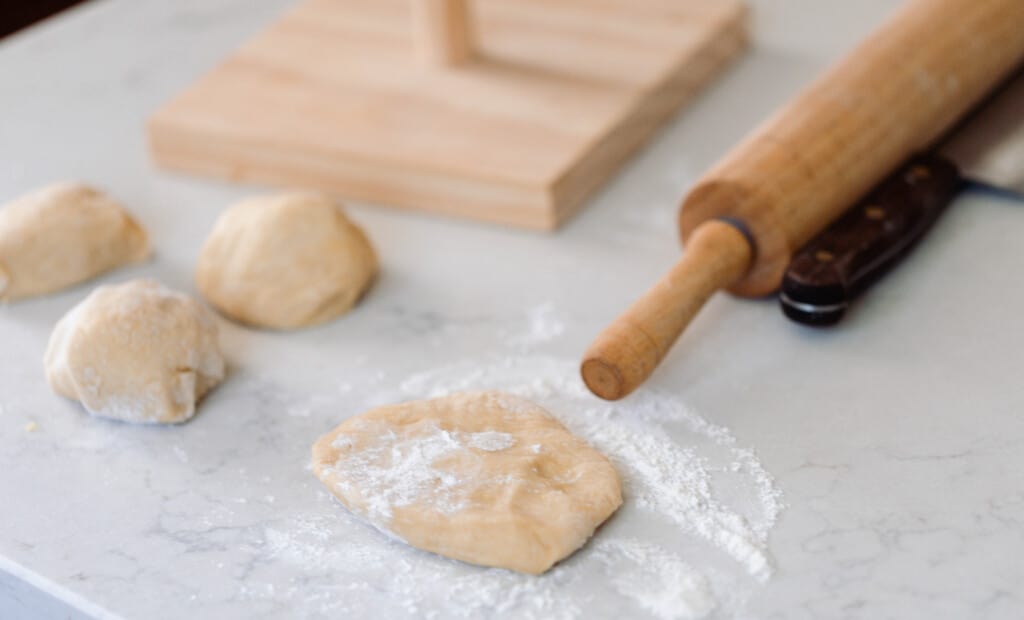
Divide dough into 8 equal parts.
Lightly dust a clean surface with flour.
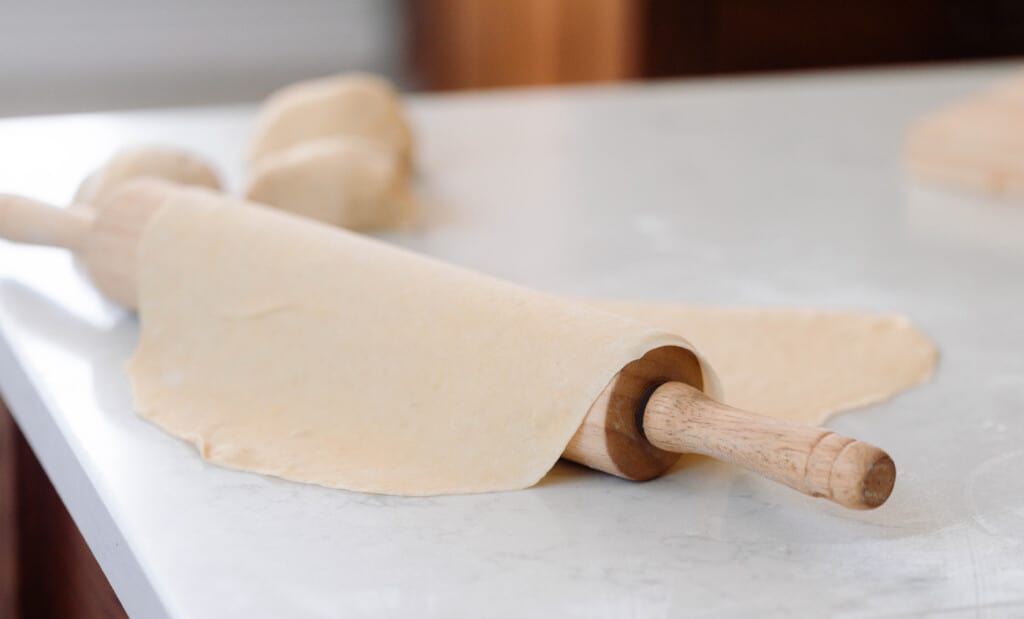
Roll the dough out as thin as possible with a rolling pin and cut with a sharp knife or pizza cutter.
Move the pasta to a towel and lay flat to dry, or hang on a pasta drying rack and allow to dry for at least 30 minutes (and up to 2 hours).
To shape pasta with a pasta cutter:
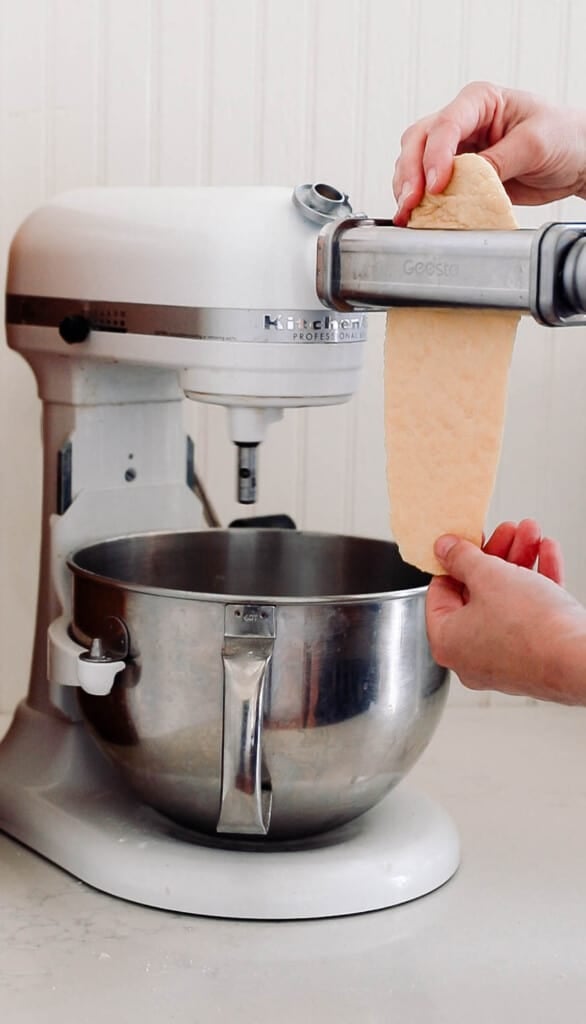
Divide dough into 8 equal parts and shape into a ball.
Flour a clean surface and pat out dough balls until it forms a 4″ by 4″ square.
Place the pasta through the pasta maker on the thickest setting (which is an 8 on my machine), catching it as it goes through.
Fold into thirds, lengthwise, then run through the thickest setting again.
If at any point the dough starts to get too sticky, place it on a floured surface and pat the flour over the entire surface of the dough.
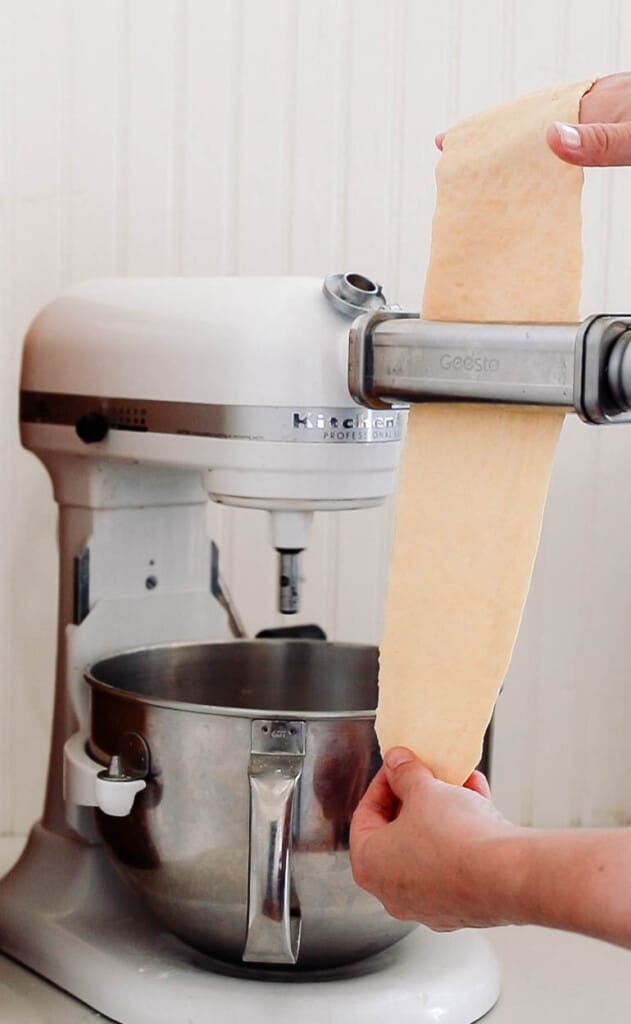
Continue running the dough through the pasta maker, changing the setting lower and lower each time.
Once the dough has passed through the thinnest setting, change out the attachment to the pasta cutter.
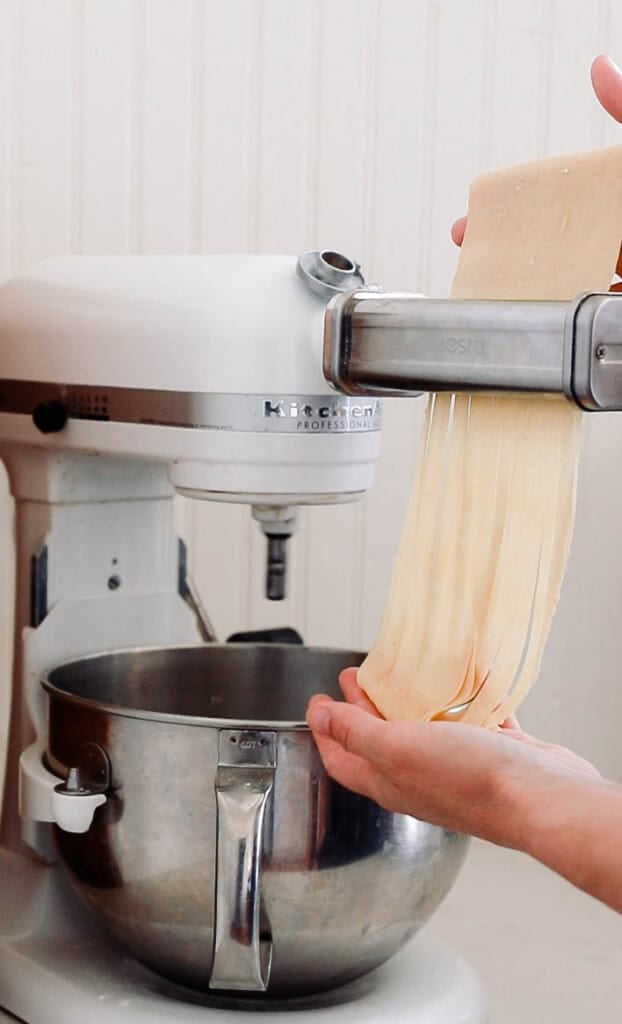
Run dough one last time though the cutter, guiding it and catching the pasta strands as they come out.
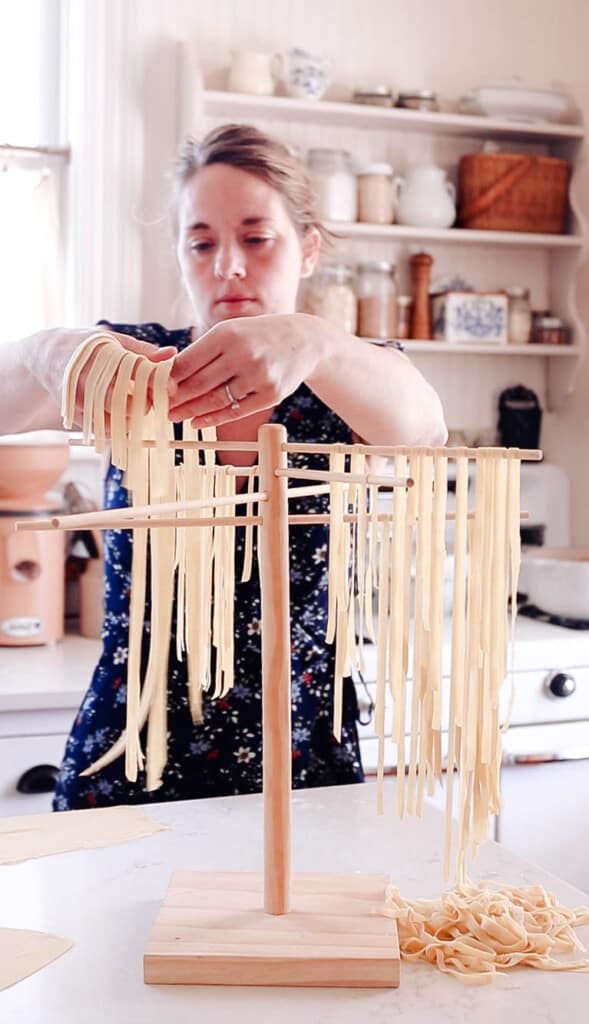
Lay flat to dry on a towel, or hang on a pasta drying rack and allow to dry for at least 30 minutes (up to 2 hours).
How To Cook Sourdough Pasta
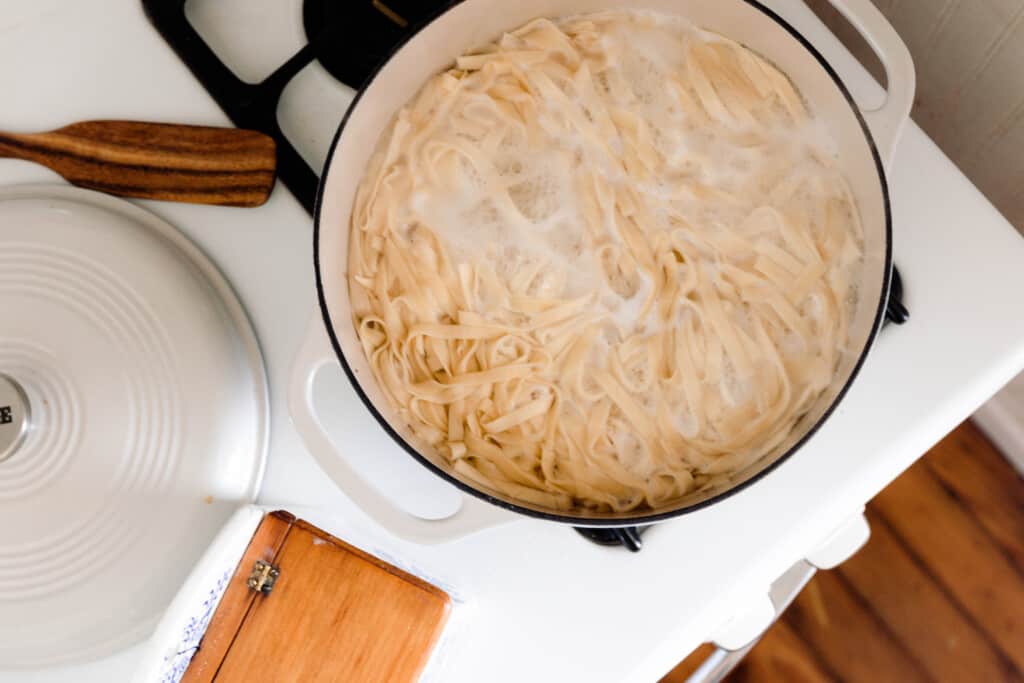
Fill a large pot with water, season well with salt, and bring to a boil.
Add the fresh pasta to boiling water and boil for 4-5 minutes stirring with a fork to loosen up the noodles.
Fresh pasta doesn’t need to be cooked as long as dried pasta.
When the noodles have reached ‘al dente’ texture and are cooked through, strain and add your favorite sauce. I love this creamy pumpkin pasta sauce or for a more protein packed meal – creamy chicken and mushroom pasta.
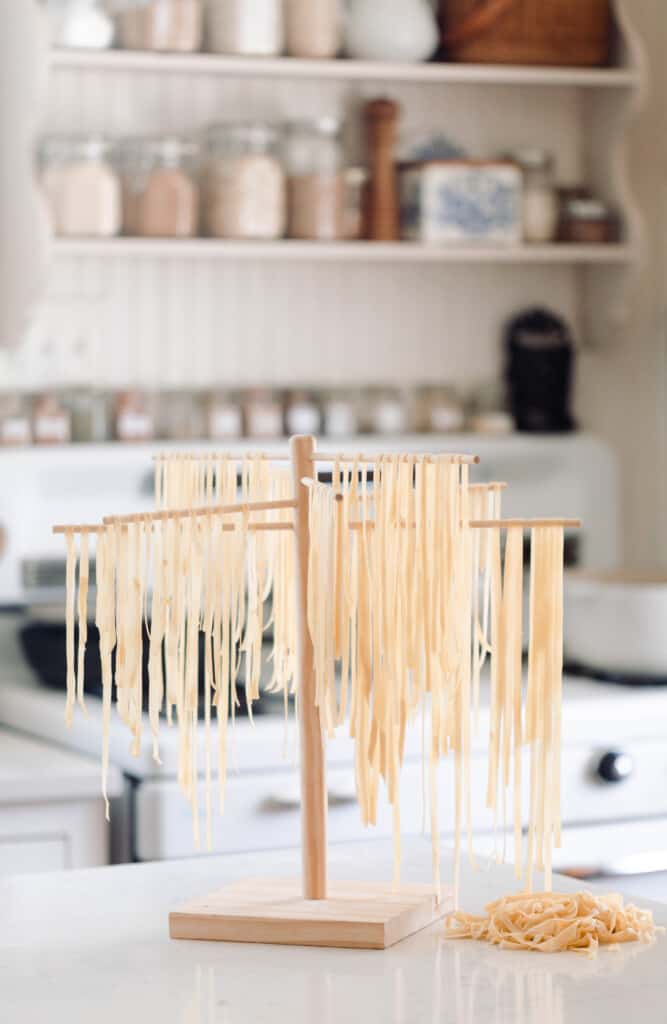
Storage:
Store pasta in an airtight container in the refrigerator for 2-3 days, or in the freezer for up to 8 months. Thaw in the refrigerator before cooking from frozen.
For longer term storage without freezing: Allow your pasta to dry out for 24 hours in a cool dry place. Turn your pasta every few hours so there aren’t any moist spots. O
nce the pasta is completely dry, transfer to an airtight container like a mason jar or Ziploc bag for up to a year.
You can also dry pasta in a dehydrator for 2-4 hours or until completely dry
Find More Sourdough Dinner Ideas:
- Beef carnitas with sourdough tortillas
- Sourdough Chicken Pot Pie
- Sourdough Fried Chicken
- Meatball Subs On Homemade Rolls
If you try this recipe and love it, I would love if you could come back and give it 5 stars!
Sourdough Pasta
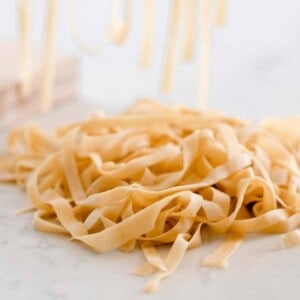
Ingredients
- 1 cup sourdough starter, discard or fed
- 3 cups all-purpose flour
- 4 large eggs
Instructions
Create The Dough
- Place the ingredients in a stand mixer with a dough hook.
- Mix on low/medium until the dough is smooth and stretchy, about 10 minutes.
- Allow the dough to rest for 30 minutes.
To Shape Without A Pasta Maker
- Divide dough into 8 equal parts.
- Lightly dust a clean surface with flour.
- Roll the dough out as thin as possible with a rolling pin and cut with a sharp knife or pizza cutter.
- Move the pasta to a towel and lay flat to dry, or hang on a pasta drying rack and allow to dry for at least 30 minutes (and up to 2 hours).
Shaping With A Pasta Maker
- Flour a clean surface and pat out dough balls until it forms a 4″ by 4″ square.
- Place the pasta through the pasta maker on the thickest setting, catching it as it goes through.
- Fold into thirds, lengthwise, then run through the thickest setting again.
- Continue running the dough through the pasta maker, changing the setting lower and lower each time.
- Once the dough has passed through the thinnest setting, change out the attachment to the pasta cutter.
- Run dough one last time though the cutter, guiding it and catching the pasta strands as they come out.
- Lay flat to dry on a towel, or hang on a pasta drying rack and allow to dry for at least 30 minutes (up to 2 hours).
Cooking
- Fill a large pot with water, season well with salt, and bring to a boil.
- Add the fresh pasta to boiling water and boil for 4-5 minutes stirring with a fork to loosen up the noodles.
- When the noodles have reached ‘al dente’ texture and are cooked through, strain and add your favorite sauce.
Notes
- You can also create the dough by hand. Add flour to a clean surface, make a well. Add eggs and sourdough starter to the well and whisk together the wet ingredients. Incorporate the rest of the flour and knead by hand for 10 minutes or so.
- If at any point the dough starts to get too sticky, place it on a floured surface and pat the flour over the entire surface of the dough.
- For a long fermented version: Instead of only allowing the dough to rest for 30 minutes, allow it to ferment covered for 2-6 hours and then refrigerate up to 24 hours. You want to cover it so it doesn’t dry out.
Nutrition
Nutrition information is automatically calculated, so should only be used as an approximation.
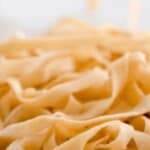


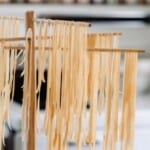

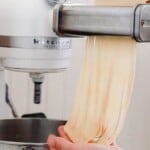
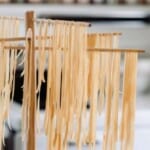



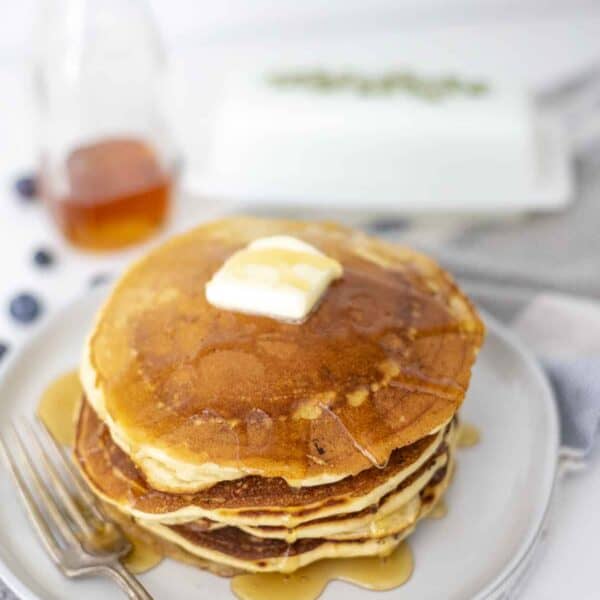






Please start using weight measurements! 😭
Hi Kristen! Thank you for this feedback! I’ll keep this in mind. You can always reference my conversion chart to convert any recipe into grams: https://www.farmhouseonboone.com/baking-conversion-chart Hope that helps!
Mine is too sticky and I needed it extra with more flour and it’s still sticky and tearing. What went wrong?
Same here. My dough was sticky as well. I wonder if the hydration in the starter has something to do with it. I’m going to guage it and add more flour so it doesn’t stick to my bowl when I’m using the dough hook. I switched to a paddle and that helped but it was still too sticky.
The hydration of the starter can definitely have an impact on how sticky the dough is. I would add a little more flour until it wasn’t sticky.
Did you have any luck? I’ve made sourdough pasta a few times but today was my first time trying with freshly ground flour- hard red wheat. And it was so sticky… after adding what felt like a ton more flour- I ended up chunking it all because it was sticking to everything. Just curious if I need to change something up.
Could you use this dough, but make it tortellini?
I would think so. Have not personally tried it, but it should work.
Hi Lisa! I’m making these now and super excited. I was wondering if I could double this and save some for another day, and if so, what you would recommend for storage? Thanks so much for all you do, love your site!
Looks like she never saw this and replied. Pasta dough does not keep well longer term. It actually can turn rather green and sickly looking. If you make the pasta into its final shape, you have a few more options, including drying/dehydrating, or freezing. Even then most people recommend not trying to store it longer than a month or two (some say up to 8 months, but I have not had great luck beyond a month or two myself).
Can I use semolina flour instead of all purpose? This is how I make my pasta but wanted to try this sourdough version.
^I was also wondering this!:)
I have never tried it. If you try it let me know how it works or what adjustments need to be made!
I used Semolina & 00 flout for this recipe & it worked out great. I even did the long ferment on it as well. The consistency of my pasta was excellent & the taste was awesome. Please see my measurements below:
1½ cup + 2 TBSP – Semolina Flour
1½ cup + 2 TBSP – 00 Flour
Everything else I kept the same & followed the directions accordingly. I hope this helps anyone looking to use Semolina in this recipe.
It’s like you made this recipe just for me.
How do I make the sourdough starter
Can I use einkorn flour?
Do your have to boil if USiNg this dough for lasagna?
No, but I would just add a little extra liquid to the sauce.
Did you try using fresh ground flour? DO you think it would work the same?
I made it with freshly ground whole wheat flour and it worked fine for me.